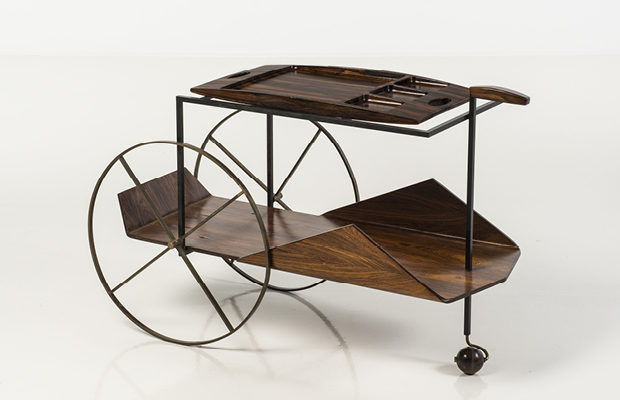 PIASA
PIASA
Design
Delving Deeper
A TEA TROLLEY BY JORGE ZALSZUPIN PUTS A MODERN SPIN ON A RELIC OF EARLIER TIMES
LOT 36 Piasa Design do Brasil sale, July 7, 2016: Carrinho de Chá tea trolley designed by Jorge Zalszupin, 1959. Estimated at €14,000–€18,000 ($15,200– $19,600), the piece sold for €27,757 ($30,000). Some reasons for the high price:
IMMIGRANT IN THE PALACE
Though he was born in Warsaw, Poland, Jorge Zalszupin’s legacy in design is almost unflinchingly Brazilian. At just shy of age thirty, he emigrated from postwar Europe to the fertile design landscape of developing Brazil. While he initially worked under fellow Polish architect Luciano Korngold, Zalszupin had been drawn to Brazil by the modernist work of Oscar Niemeyer—which demonstrated “none of that clinging to the past,” in contrast to design in postwar Europe. He had been trained as an architect in Europe and, after two years with Korngold, began his independent work in Brazil designing residences for the elite of São Paulo. Not coincidentally, his arrival in South America accompanied the development of a modern ideal for Brazil, soon to manifest specifically in Brasília, the new federal capital. Niemeyer as the architect and Lucio Costa as the urban planner envisioned the now legendary cityscape, conjuring a modern (nearly morphing into futuristic) metropolis. Zalszupin was one of a handful of designers enlisted to contribute furniture to the buildings, including the Palácio do Planalto and Palácio da Alvorada, the official workplace and residence, respectively, of the president. Zalszupin’s furniture designs were clearly heavily influenced by Niemeyer’s architecture, at times appearing almost as evocations of his buildings, with well-proportioned shapes supported by elegant spindles, often questioning the authority of gravity in their pose.
L’ATELIER
Zalszupin established L’Atelier in 1959 to navigate the void between industrialization and modernization in Brazil. As he recounted, “the problem was [this]: Who would make the stuff we were designing?” Fashionable Brazilians desired modern furniture to outfit their new modernist houses, but imports were challenging to obtain and the Brazilian market lacked sufficient infrastructure to produce high quality designs. Named to denote both experimentation and production, L’Atelier at first included just three carpenters to craft Zalszupin’s furniture, but it came to include architects, engineers, and other craftsmen to take the design process from initial research to full production. Inspired by Danish furniture, the work celebrated natural materials, incorporating metals and focusing particularly on Brazilian woods, sourced locally. L’Atelier’s output is characterized by robust forms juxtaposed with slender lines, the natural hues of wood and leather massaged into a harmonious, organic color palette—an homage to the materials themselves. “We know Zalszupin was a wood lover,” says Frédéric Chambre, associate vice chairman and chief executive at Piasa, “and these pieces represent affirmation of his passion.” Objects such as this tea trolley arose from the new social vogue for entertaining in people’s modern domestic interiors. In it, Zalszupin adapted the structure of portability and elegance he knew from Polish baby buggies. Unassuming but extraordinary in its refined form and thoughtful details, the trolley’s removable wooden planes almost levitate in concerted geometries, held in position by brass spindles. And thus, with a new social itinerary, the tea trolley, a remnant of an earlier era, became modern design.
BRAZILIAN BOOM
The Piasa sale, presented in partnership with Bolsa de Arte in Rio de Janeiro, featured nine lots by Zalszupin, all of which sold—most above estimate—with the tea trolley near the top of the list. According to Chambre, this was the first auction in Europe dedicated exclusively to Brazilian design, and, he noted, “Collectors and design lovers were impatient to see and discover the creations.” The sale was priced based on established estimates by Brazilian auction houses, but adjusted to meet perception by the European and broader global market. Most pieces came from private collections that had possessed them since fabrication, contributing to their rarity. With active bidding from international sources on the phone and web, the tea trolley was carted off to another modern home.









